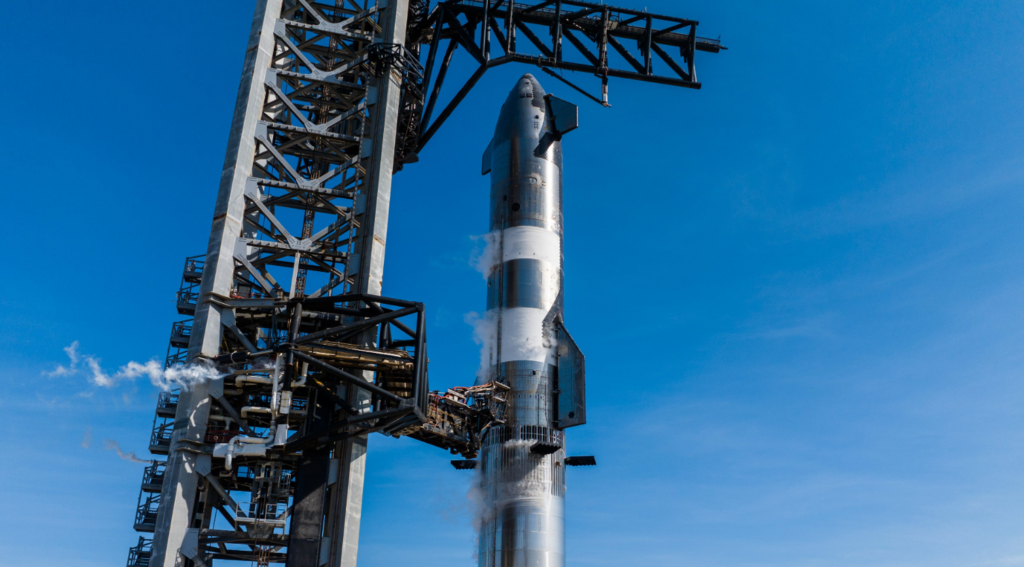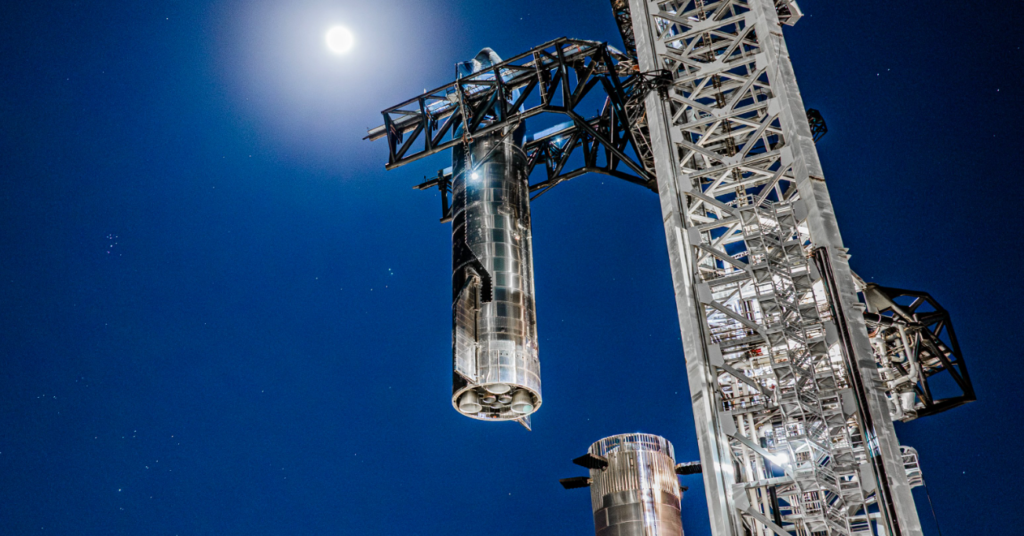Right now we’re just about 24 hours away from Flight Test 6 of Starship as SpaceX completes some of the final preparations and pre-launch activities. Just in the last few days, we saw the flight termination system (FTS) installed along with a full wet dress rehearsal.
Tomorrow when they launch, we’re expecting a few significant changes to the flight profile including the actual time of liftoff, heat shield alterations, an engine relight, etc.
Ready For Launch

Starting late last week the booster made the journey from Starbase over to the launch site. Soon after it was put on the Orbital Launch Mount and then the ship was stacked on top. Around that time we also got confirmation that the Flight Termination System was installed.
This leads up to yesterday when SpaceX tweeted saying, “Propellant load test and preflight checkouts complete ahead of Starship’s sixth flight test.” This included some images during the successful wet dress rehearsal. At this point they are basically ready to go and everything looks in place for a launch tomorrow afternoon.
Specifically, in a statement from the company, they said, “The sixth flight test of Starship is targeted to launch Tuesday, November 19. The 30-minute launch window will open at 4:00 p.m. CT. In the past, practically all 5 flight tests so far have occurred just after sunrise. This provides some great views during the initial launch sequence but hinders the ship’s landing, at least from a viewing perspective. Due to the fact that ship travels all the way to the Indian Ocean off the coast of Australia, we’ve only ever seen the ship landing burn and flip at night time.
In the same statement, SpaceX clarified, “adjusting the flight’s launch window to the late afternoon at Starbase will enable the ship to reenter over the Indian Ocean in daylight, providing better conditions for visual observations.
When looking at the buoy angle from Flight 5, while it helps give an idea of what’s happening and the state of the upper stage, a daytime angle would make a big difference. Something we can hope to see tomorrow about an hour after liftoff.
That being said, the upper stage will need to make it through Earth reentry first. SpaceX was quoted saying, “Several thermal protection experiments and operational changes will test the limits of Starship’s capabilities and generate flight data to inform plans for ship catch and reuse. The flight test will assess new secondary thermal protection materials and will have entire sections of heat shield tiles removed on either side of the ship in locations being studied for catch-enabling hardware on future vehicles. The ship also will intentionally fly at a higher angle of attack in the final phase of descent, purposefully stressing the limits of flap control to gain data on future landing profiles” they said.
These statements highlight that the company has now seen the ship reenter the atmosphere a few times, one in better condition than the other, and is trying to refine the heat shield system. This not only includes the tiles and protection system itself, but also placement along the ship.
Starship’s upper stage will fly the same suborbital trajectory as the previous flight test, with splashdown targeted in the Indian Ocean. The one other big change for the ship that will determine whether or not it makes it to reentry will be the engine relight. On this flight, they’ll be attempting an in-space burn using a single Raptor engine, with the intention of demonstrating the capabilities required to conduct a ship deorbit burn prior to orbital missions.
Part of the reason SpaceX is trying all these different upper stage milestones and messing with the heat shield has to do with the fact that soon we will begin seeing Starship V2. This new upper stage variant is expected to be used on Flight Test 7 and has some serious physical changes including its size and notably the flap positions.
Here, the newer version of Starship has the forward flaps shifted leeward. This is meant to help improve reliability, ease of manufacturing, and payload to orbit. It’s also meant to withstand reentry heating much better than what we’ve seen so far on Flights 1 through 5 with Starship V1. Flight Test 6 is set to be one of the last examples of this older hardware.
A Busy Flight Profile

With the full flight profile released, we now have an exact idea of each mission milestone and when they’re set to occur. This begins with the Flight Director conducting a poll and verifying GO for propellant load more than an hour before liftoff.
At around T – 49:50, they will begin loading liquid methane into the ship, followed soon after by liquid oxygen. Less than 10 minutes later and the same will begin for the booster, methane then liquid oxygen. At T – 19:40, the Raptors begin engine chill on the booster and ship. Finally, in the last few minutes, the ship and booster propellant load will be completed, followed by a go for launch, and the activation of the water deluge system.
We’ll then see ignition of the 33 Raptors and then liftoff. Overtime SpaceX has worked to speed this process up and get the rocket off the ground a bit faster than the original test flights. At T + 1:02 the rocket will reach Max Q, which is the moment of peak mechanical stress. About a minute and a half later we will see MECO (which SpaceX calls Most Engine Cut Off) and then hot staging.
This is where some big mission milestones occur similar to the last flight. SpaceX has confirmed that they are planning to attempt a second booster catch just like Flight Test 5. The company was quoted saying, “The success of the first catch attempt demonstrated the design feasibility while providing valuable data to continue improving hardware and software performance. Hardware upgrades for this flight add additional redundancy to booster propulsion systems, increase structural strength at key areas, and shorten the timeline to offload propellants from the booster following a successful catch. Mission designers also updated software controls and commit criteria for the booster’s launch and return.
In regard to the flight profile, and “Analogous to the fifth flight test, distinct vehicle and pad criteria must be met prior to a return and catch of the Super Heavy booster, which will require healthy systems on the booster and tower and a final manual command from the mission’s Flight Director. If this command is not sent prior to the completion of the boostback burn, or if automated health checks show unacceptable conditions with Super Heavy or the tower, the booster will default to a trajectory that takes it to a landing burn and soft splashdown in the Gulf of Mexico. We accept no compromises when it comes to ensuring the safety of the public and our team, and the return will only take place if conditions are right” they said.
Its important to point out that while SpaceX managed to catch the booster on the last flight, this process is far from guaranteed as they make changes and once again attempt what many thought was impossible. We also learned not long after Flight 5 that the margin between the catch happening and an abort that would send the booster toward the ground was really small.
Either way, during its return, the booster will slow down from supersonic speeds, resulting in audible sonic booms in the area around the landing zone. They highlight that “Generally, the only impact to those in the surrounding area of a sonic boom is the brief thunder-like noise with variables like weather and distance from the return site determining the magnitude experienced by observers.”
If everything goes according to plan, the booster landing burn will start at T + 6:38, with a catch just 22 seconds later. At T + 8:27, the upper stage will cutoff its engines and begin its coast. This time, however, between engine cutoff and reentry, we can expect the engine relight demo at T + 37:46.
This will be followed by reentry and then a flip maneuver and splashdown just past an hour into the flight. In regard to the ship, SpaceX said, “Future ships, starting with the vehicle planned for the seventh flight test, will fly with significant upgrades including redesigned forward flaps, larger propellant tanks, and the latest generation tiles and secondary thermal protection layers as we continue to iterate towards a fully reusable heat shield. Learnings from this and subsequent flight tests will continue to make the entire Starship system more reliable as we close in on full and rapid reusability” they said.
In other words, Flight Test 7 is set to be a big deal, and reveal a new generation of Starship prototypes. When talking about Flight 5 the company said, “Starship’s fifth flight test was a seminal moment in iterating towards a fully and rapidly reusable launch system. On the first attempt, the Super Heavy booster successfully returned to the launch site and was caught by the chopstick arms of the launch and catch tower at Starbase. Starship’s upper stage went on to demonstrate several improvements, resulting in a controlled entry and high-accuracy splashdown at the targeted area in the Indian Ocean.”
Tomorrow they are hoping for similar results to the last flight, with a few added milestones in between. Something to look forward to in the near future.
Conclusion
SpaceX is just about 24 hours away from the 6th flight test of Starship. In the last few days, we saw some of the final preparations including stacking, FTS install, and a wet dress rehearsal. Similar to the last flight they are going to attempt another booster catch, in addition to an engine relight and a ship landing during the daytime.

Hello!
Good cheer to all on this beautiful day!!!!!
Good luck 🙂